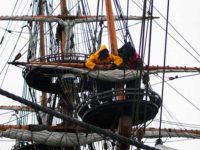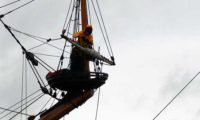I am fond of one photo I took of the Kalmar Nyckel at the Sultana Downrigging Weekend in Charlestown, MD last weekend. It shows two sailors, who appear to be starting to downrig the sprit topsail yard. They are standing on the distinctive round sprit mast top. Behind them, the round foremast top is also visible. The round top disappeared by the early 18th century, replaced by rectangular fighting tops.
The Kalmar Nyckel is a replica of a Dutch built pinnance which carried Swedish settlers to North America in 1638 to establish the colony of New Sweden, in what are now the states of Delaware, New Jersey, and Pennsylvania.
The round tops, which provided a means of supporting the upper masts, are a distinctive feature of ships from the 17th century and earlier. Another highly distinctive feature is the sprit topmast. To a modern eye it is the most unlikely of all possible places to stick a mast — right at the end of the bowsprit.
The sprit topmast supported two sails, a spritsail set under the bowsprit and a topsail set on the topmast. Both were necessary in maneuvering the ship, particularly when tacking. More modern ship use jibs, the forward most triangular sails, to accomplish the same thing. In the 17th century, the jib had not been developed for ships of this size. Instead the sprit sails were trimmed to bring the ship’s bow across the wind when tacking.
Setting, trimming and furling the spritsails was a perilous task, as they were right at the end of the bowsprit. Setting jibs was comparatively much easier and safer. When jibs came along, the sprit topmast and sails vanished. The jib stays got in the way of the mast and the structure needed to support the jib load on the bowsprit, the dolphin striker and martingale stays, got in the way of the lower sprit sail.
The Kalmar Nyckel is unusual in that there are not many ships sailing today with a sprit topmast. (Indeed, the Wikipedia entry on Sprit topmast features a photograph of the sprit topmast on the Kalmar Nyckel.)
There are other interesting details that can be seen in the photo. The fore topsail bunt is partially brailed to the foremast, as well as furled to the yard. Also, just below the fore top, you can also see the distinctive shape of a Furuno radar, as well as the ship’s electric horn. The round radar is nicely geometrically compatible with the round top, under which it is largely hidden. The horn and the radar may not be historically accurate, but are prudent all the same.


